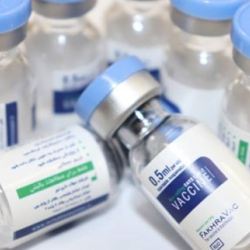The vaccines saved 2.9 million lives, prevented 12.5 million hospitalizations, and saved $500 billion in hospitalization costs, according to a recently published analysis. They were – and are – hugely important to Americans' health and prosperity.

From the onset of the COVID-19 pandemic, researchers have been engaged in forecasting the potential economic and human costs associated with an uncontrolled large-scale pandemic, as well as the corresponding benefits that could be derived from an effective COVID-19 vaccine and various degrees of its uptake. These projections have played a pivotal role in shaping both private and public responses to the pandemic.
The scientific and policy triumphs that led to developing, testing, manufacturing, and administering two doses of the original round of COVID-19 vaccines to approximately 80% of the U.S. population aged 12 and above (fully vaccinated) is noteworthy. And it was done in record time: Operation Warp Speed (OWS) was a public-private partnership that produced COVID-19 vaccines in the unprecedented timeline of less than one year. The first vaccine was ready for the public in January 2021, beating the previous record for vaccine development by several years. OWS made available more than 63 million doses within one year. That remarkable success is widely attributed to its prodigious funding, effective coordination, and command leadership structure.
The safety and effectiveness of the first round of COVID vaccines were stunning. Their ability to prevent infection by the original Wuhan variant of the SARS-CoV-2 virus was clear from the FDA's summary of Pfizer's clinical trial data presented by the FDA to its vaccines advisory committee in December 2020. In the pivotal clinical trial, which included more than 44,000 subjects, the two criteria for efficacy were the prevention of (1) a positive virological test plus (2) at least one COVID-19 symptom. If the vaccine met those criteria, it would be considered to be efficacious at preventing infection. The FDA's "Efficacy Summary" concludes:
The data submitted in this EUA [Emergency Use Authorization] request were consistent with the recommendations set forth in the FDA Guidance on Emergency Use Authorization for Vaccines to Prevent COVID-19 and met the prespecified success criteria established in the protocol. In the planned interim and final analyses, vaccine efficacy after 7 days post Dose 2 was 95%, (95% CI 90.3; 97.6) in participants without prior evidence of SARS-CoV-2 infection and >94% in the group of participants with or without prior infection. (Emphasis added.)
However, the SARS-CoV-2 virus, which causes COVID-19, underwent numerous mutations and exchanges of genetic material, and some new variants were resistant to the vaccines. Although the original vaccines and subsequent boosters continued to offer protection against severe disease, hospitalization and death, they were less able to prevent infection. Consequently, as of November 2022, it was estimated that about three-quarters of the U.S. population had been infected by COVID-19 at least once. The Omicron variant, which first hit the U.S. in late 2021, was capable of partial immune escape from either previous infection or vaccination and demonstrated high transmissibility both in the U.S. and globally.
The currently dominant variant of the SARS-CoV-2 virus is a hyper-mutated, immune-evasive derivative of Omicron called JN.1. Fortunately, there is some cross-reactivity for neutralizing antibodies between JN.1 and XBB.1.5, the virus whose spike protein is the immunogen in the most recent COVID booster, which is why that booster (introduced last September) is moderately effective at preventing serious illness, hospitalization, and death.
But, as Scripps Research’s Dr. Eric Topol says: “That’s luck, folks. It may not happen again with the next ‘updated’ booster in 2024 or 2025.” If a future booster were to be a poor match for the dominant circulating virus, we could experience the return of a new deadly, pandemic surge of infections.
On January 4, the Progressive Policy Institute released a report that was an important reminder of the value to society of COVID vaccines. Its retrospective component, based on the available evidence, describes the economic and health benefits of a rapidly developed COVID-19 vaccine in comparison to theoretical scenarios that include no vaccine and a more rapid roll-out of the vaccine at the onset of 2021. It concludes:
Employing conservative assumptions, the report finds that the COVID-19 vaccines saved 2.9 million lives, prevented 12.5 million hospitalizations, and saved $500 billion in hospitalization costs. This is in comparison to the counterfactual scenario of no successful vaccine, relying instead on the development of natural immunity through infection.
The report also calculates the benefits to different demographic groups from annual COVID-19 boosters. One such calculation shows that “the expected 5-year economic losses to an individual choosing not to receive boosters rises from $654 at age 30 to more than $65,000 at age 75.”
Such conclusions make clear the critical importance of continuing to update boosters to keep up with the evolution of the SARS-CoV-2 that is inevitable given the number of infections and the amount of viral replication and mutation that are occurring.
But updating the vaccines is not enough. There is a saying in the infectious disease community that vaccines don’t prevent illnesses; vaccinations do. The rate of vaccination with the currently available COVID boosters is a dismal 19%. We can and must do better.
